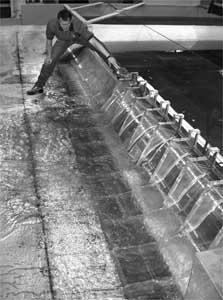Utah Water Research Laboratory aids world
The Utah Water Research Laboratory (UWRL) of Utah State University works to solve water-related problems for the state, nation and world.
The UWRL is a division of USU’s civil and environmental engineering department and is located at 1600 Canyon Road near First Dam.
Jan Urroz, supervisor of Administrative Services and Infrastructure, said the building opened in 1965, but research has been done there since 1959. The UWRL is home to the Hydraulics Laboratory and the Environmental Quality Laboratory (EQL).
“We are one of few centers in the nation with this large a hydraulics lab,” Urroz said.
Furthermore, the United States Department of Interior named the UWRL as one of the top 52 centers in the United States, she said.
The 50,000 square-foot hydraulics section tests a variety of pumps, pipelines and valves. Until Wednesday, the Logan River was being diverted through a channel down the center of the laboratory to allow for repairs on First Dam, she said.
The hydraulics division contains a rainfall simulator used to test various types of erosion. In addition, studies are often done using models built to scale. There is a model of the Guadalupe River in California for testing flow patterns, Urroz said.
More than 25 faculty members and more than 100 graduate students do the testing.
“They get real hands-on experience and practical application here,” Urroz said.
Tyler Smith, a graduate student studying hydraulics, agreed.
“This is a great place to work,” he said. “You actually get to test the things you learn about in class.”
Smith is doing his master’s paper on minor losses through PVC pipe fittings and said he hopes to get a good job with an engineering firm in the future.
Those who don’t work in hydraulics may work in the 11,000 square-foot environment division. The EQL combines chemistry and microbiology, she said.
Susan Robison, a research technician, is working with microbes to test soil for Hill Air Force Base.
“We want the microbes to eat the harmful chemicals in the soil,” she said.
Hill Air Force Base is one of many institutions that solicit the skills of the UWRL. Funding for these projects comes from various departments of the federal and state governments and engineering firms, Urroz said.
Mac McKee, associate director of the UWRL, said this year’s budget will be more than $8,000,000. A portion will go toward teaching the increasing population of Utah about the need for managing water and waste.
“We provide training in every single county in the state,” McKee said.
Students are working on a project to help farmers in the Seviere river basin of Utah manage their scarce water – to make it stretch further. They are using an advanced, never-before-used-modeling technique, he said.
“As of last Friday, the technology is giving near-perfect results,” McKee said.
This technology may be used to solve other problems. It will be published in technical journals that are read all around the world, he said.
The UWRL’s influence is felt internationally. It just received a contract from the state to help design curriculum and expand faculty capabilities for a Palestinian university, McKee said.
The UWRL plans to aim future efforts toward better acquisition of data at a cheaper cost. Increased demands for water can only be managed by gaining information, he said.
“The first item of business is to continue to serve the needs of the people in Utah in terms of water management,” McKee said.
Students, as well as Americans in general, tend to take their water supply for granted. They should get a better feel for where the water comes from, he said.
“People don’t realize how much science, technology and creativity goes into that,” McKee said.
Anyone who would like a tour of the UWRL or to find out more about water should call 797-3157 or 797-3155.

Mike Johnson, assistant research professor at the Utah Water Research Laboratory, opens a flood gate on a scale model of a dame representing one near Austin, Texas. (Scott Davis )

